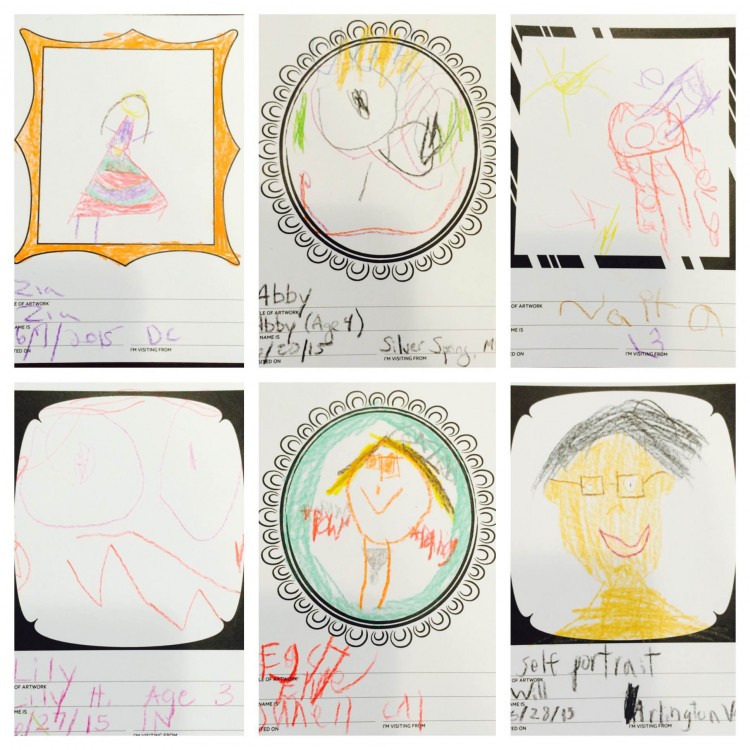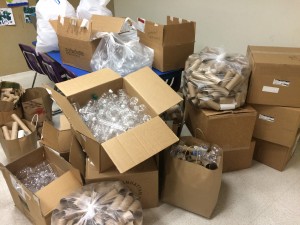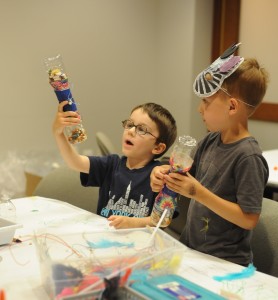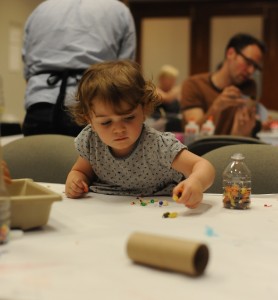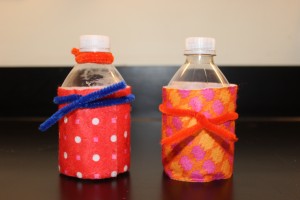Over the course of the American Moments exhibition, we’ve been featuring some of our favorite drawings from our in-gallery interactive. Below are a handful of portraits by some of our younger artists. Thanks Zia, Abby, Naita, Lily, Ellie, and Will for your contributions!
Deconstructing Lawrence’s Struggle Series: Panel 23

Jacob Lawrence, Struggle … From the History of the American People, no. 23: if we fail, let us fail like men, and expire together in one common struggle . . .— Henry Clay, 1813, 1956. Egg tempera on hardboard, 16 x 12 in. Private Collection of Harvey and Harvey-Ann Ross. © 2015 The Jacob and Gwendolyn Knight Lawrence Foundation, Seattle / Artists Rights Society (ARS), New York
This spring, former Phillips curator Beth Turner taught an undergraduate practicum at the University of Virginia focusing on Jacob Lawrence’s Struggle series. In this multi-part blog series, responses from Turner’s students in reference to individual works from the series will be posted each week.
…If we fail, let us fail like men, and expire together in one common struggle…–Henry Clay
Depicted here is the solitary American seaman described in Henry Clay’s 1813 speech which called for action against British violation of U.S. maritime rights. Clay was a prominent War Hawk, distinguished as those who favored war with the British. In his speech, Clay declared that America must stand up for the rights of their sailors.
The sailor’s face reveals his excruciating death just seconds after a sword pierces his eye, as his own weapon collapses from his lifeless hand. Lawrence’s use of the part to represent the whole allows the viewer to associate the invisible assailant with the unfolding scene without having to explicitly present him.
The image is accompanied by an abridged version of a quote from the full text of Henry Clay’s speech in 1813. Jacob Lawrence chose this particular quote to complement the dramatic image because it emphasizes that the “one common struggle,” even though it may be from different times and for different people, calls for sacrifice and dedication in the same way.
Amy Woo and Andrea Goldstein
How to: Make a Musical Maraca at Home
On June 6 and 7, almost 6,000 visitors attended Jazz n’ Families Fun Days, the Phillips’s annual family festival in partnership with DC Jazz Festival. Families decorated maracas, listened to live jazz music, played instruments, and joined gallery tours. In preparation for this big event, Phillips Education staff spent the last couple months collecting thousands of water bottles and toilet-paper rolls for the Family Fun art project – musical maracas! Check out these before and after photographs showing the innovative and creative ways visitors transformed recyclable materials into instruments that were as artistic as they were musical.
Before:

View from above the mass of recycled water bottles during preparation for Jazz n’ Families Fun Days. Photo: Hayley Prihoda
After:
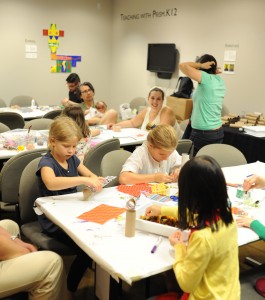
Visitors of all ages enjoyed creating their musical maracas in our art studio. Photo: Joshua Navarro
You can make a musical maraca at home with your family! This project is fun, engaging, and accessible for all ages.
WHAT YOU NEED:
- Toilet paper rolls or water bottles (you can use both, or one or the other)
- Beads or any dried food in your kitchen pantry, such as beans, pasta, or rice.
- Decorative materials (colorful duct tape, tissue paper, scrapbook paper, pipe-cleaners, etc.)
SUGGESTED AGE:
- 4 and up (possible for younger ages with adult supervision)
TIME FRAME:
- 30 minutes – 1 hour
HOW TO BUILD A MARACA:
There are two easy ways to construct your musical maraca.
Option 1
Step 1: Clean, rinse and dry plastic water bottle. Any size bottle will work!
Step 2: Select beads or dried food for the inside (beads/food may be visible so think about the colors you want to choose)
Step 3: Pour beads/dried food into the water bottle
- Tip: Use a piece of paper as a funnel to make this process easier and cleaner
- Tip: Fill up halfway to allow room for beads to shake
Step 4: Close water bottle cap
Step 5: Decorate the outside of your maraca!
To further extend your project, create two maracas and attach a toilet paper roll in between to form a handle. Duct tape is recommended.
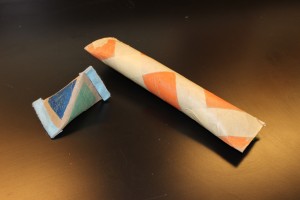
(Option 2 examples) A triangular maraca made out of a toilet paper roll (on left) and a rain stick made out of a paper towel roll (on right). Photo: Hayley Prihoda
Option 2
Step 1: Select a toilet paper roll or paper towel roll
- Tip: A toilet paper roll will create a hand-held maraca; a paper towel roll will create a rain stick
Step 2: Pinch one end together and seal by stapling
Step 3: Pour beads/dried food into the tube
Step 4: Close other end with staples
- Tip: You can either pinch the edges together in the same direction as the other end or in the opposite direction to create a triangle shape (see photograph below)
Step 5: Decorate the outside of your maraca!
Re-purposing materials is a great way to save money, think creatively and reduce waste! Here are a few more ideas for reusing your recyclable goods this summer:
- Soda Bottle Bird Feeders
- DIY Chia Pets (scroll down)
- Enchanted Fairy Houses
Check back soon as we begin our Phillips-at-Home Summer Series, bringing our collection to you through art-making activities inspired by our artworks!
Hayley Prihoda, K12 Education Intern

